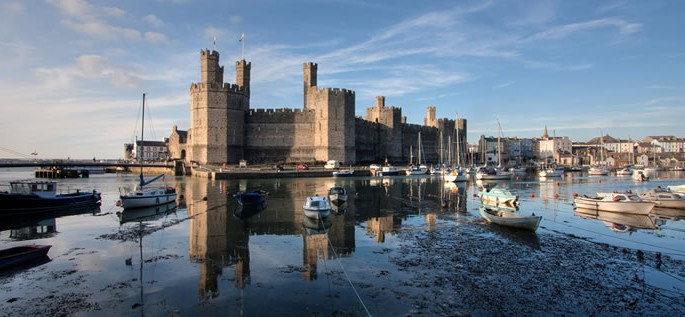Welsh

Welsh (Cymraeg) is a member of the Brythonic (or British) group of the Celtic branch of the Indo-European language family. It is spoken by 562,000 people in the north, west, and south of Wales (Ethnologue). Ethnologue estimates that there are 591,000 users of Welsh worldwide.
With the Germanic and Gaelic colonization of Great Britain, the Brythonic speakers in Wales were split off from those in other parts of Britain. As a result, the languages diverged and became Welsh, Cornish, and Cumbrian. The latter became extinct in the 11th century.
Welsh is the de facto provincial language in Wales. There are large numbers of Welsh people who speak Welsh, but monolingual speakers of Welsh are relatively rare today since most Welsh speakers speak English. English-Welsh code-switching is a very common phenomenon.
The U.K. government has ratified the European Charter for Regional or Minority Languages with respect to Welsh. Although Welsh is a minority language, and thus threatened by the dominance of English, support for the language grew during the second half of the 20th century, along with a rise of nationalism. Welsh is compulsory in most Welsh schools up to age 16. Many Welsh primary and secondary schools provide Welsh-medium education to over 82,000 children. The language is widely used on the radio and TV. It is the language of daily communication in many parts of Wales. Most people in Wales believe that Welsh should have equal status with English.
Dialects
Welsh is usually divided into Northern (Cymraeg y gogledd) and Southern (Cymraeg y de) dialects that differ in pronunciation, grammar, and vocabulary. The differences between the dialects are much more pronounced in the spoken than in the written language. Patagonian Welsh spoken in Argentina is influenced by the surrounding Spanish.
Structure
Welsh phonology shares many features with that of other Celtic languages.
Vowels
Welsh has 13 vowels although not all them occur in all dialects. A distinguishing feature of Welsh vowels is length which makes a difference in word meaning. In Southern dialects, the contrast between long and short vowels is found in stressed syllables only, while in Northern dialects, the contrast is found only in stressed word-final syllables.
|
Front
|
Central
|
Back
|
|
|---|---|---|---|
|
Close
|
i:
|
ɨ:
|
u:
|
| Close-mid |
I
|
ɘ
|
ʊ
|
|
Mid
|
e:
|
ə
|
o:
|
| Open-mid |
ɛ
|
ɔ
|
|
|
Open
|
a
|
ɑ
|
- /ɨ:/ and /ɘ/ are found only in Northern dialects. In Southern dialects, they have merged with /i/ and /I/.
- /i/ = ee in beet
- /e/ = ai in bait
- /ɛ/ = e in bet
- /ɨ/ = e in roses
- /ə/ = u in bud
- /a/ = a in bat
- /u/ = oo in boot
- /ʊ/ = oo in hook
- /o/ = oa in boat
- /ɔ/ = o in bog
- /ɑ/ = a in spa
In addition to the vowels listed above, there are also many diphthongs.
Consonants
The full inventory of Welsh consonant phonemes is given below.
|
Bilabial
|
Labiodental
|
Dental
|
Alveolar
|
Postalveolar
|
Palatal
|
Velar
|
Glottal
|
||
| Stops | voiceless |
p
|
t
|
k
|
|||||
| voiced |
b
|
d
|
g
|
||||||
| Fricatives | voiceless |
f
|
θ
|
s
|
ʃ
|
x
|
h
|
||
| voiced |
v
|
ð
|
z
|
||||||
| Affricates | voiceless |
tʃ
|
|||||||
| voiced |
dʒ
|
||||||||
| Nasals | voiceless |
ŋ |
|||||||
| voiced |
m
|
n
|
|||||||
| Lateral | fricative |
ɬ
|
|||||||
| approximant |
l
|
||||||||
| Trill | voiceless |
r̥ |
|||||||
| voiced |
r
|
||||||||
| Approximant |
w
|
j
|
- /θ/ = th in thin
- /ð/ = th in those
- /ʃ/ = sh in shop
- /tʃ/ = ch in chop
- /dʒ/ = j in job
- /r, r̥/ have no equivalents in English
- /x/ = similar to ch in German pronunciation of Bach
- /ɬ/ has no equivalent in English
- /ŋ/ = ng in song
Stress
Stress in Welsh polysyllabic words falls most commonly on the penultimate (one before last) syllable.
The grammar of Welsh shares many features with the grammar of other Celtic languages. A distinguishing feature of Welsh, as of all Celtic languages, is initial consonant mutation. This means that the first consonant of a word may change depending on grammatical context. Welsh has three mutations which are illustrated below.
| Soft mutation | Nasal mutation | Aspirate mutation | |
|---|---|---|---|
|
carreg
|
y garreg
|
fy ngharreg
|
ei charreg
|
|
‘stone’
|
‘the stone’
|
‘my stone’
|
‘her stone’
|
Nouns, adjectives, and pronouns
Welsh nouns have the following grammatical categories:
- There are two genders — masculine and feminine. They are not predictable from the form of the noun.
-
Welsh has a great number of plural endings. These include –iau, -on, -en, -i, -oedd, -ed, -ad, -iaid, -aint, -er and -yr. In general these endings are added to the singular to form the plural; for example pen ‘head,’ and pennau ‘heads’.
- There are no cases, so that, for instance, possession is marked by apposition, e.g., mam y gath, literally ‘mother the cat’ means ‘cat’s mother.’
- For the most part, adjectives are not marked for gender or number.
- Welsh distinguishes between familiar and formal 2nd person pronouns, i.e., ti ‘familiar you’ — chi ‘formal you.’
- Along with decimal, Welsh also uses a vigesimal counting system, i.e., counting by twenties, as in French, Danish, and Basque.The former is more commonly used.
Verbs
Welsh verbs are marked for the following grammatical categories:
- There are three persons: 1st, 2nd, 3rd.
- There are two numbers: singular and plural.
- The preterite generally uses the analytic forms. All other tenses use compound forms with auxiliary verbs such as bod ‘be.’
- There are three moods: indicative, conditional, and imperative.
Word order
The normal word order in Welsh is Verb-Subject-Object. Adjectives normally follow the noun they modify.
While Welsh has borrowed some words from English, the bulk of its vocabulary is inherently Celtic. Below are a few common words in Welsh.
| Hello. | Helo. |
| Good morning. | Bore da. |
| Good bye. | Hwyl fawr. |
| Please. | Os gwelwch yn dda. |
| Thank you. | Diolch. |
| Yes. | Do, ydw |
| No | Naddo, nadw |
| Man | Dyn. |
| Woman | Merch |
Below are the Welsh numerals 1-10.
|
1
|
2
|
3
|
4
|
5
|
6
|
7
|
8
|
9
|
10
|
|---|---|---|---|---|---|---|---|---|---|
|
un
|
dau
|
tri
|
pedwar
|
pump
|
chwech
|
saith
|
wyth
|
naw
|
deg
|
Writing
Middle Welsh (12th-14th centuries) is well-documented, since it is the language of the Mabinogion, a collection of prose stories from medieval Welsh manuscripts. Early Modern Welsh (14th-16th centuries) was the language used by the great Welsh poet Dafydd ap Gwilym. The publication of William Morgan‘s translation of the Bible in 1588 had a strong stabilizing effect on the language. Welsh literature is the oldest in Europe after Greek and Latin, going back to the 6th century AD. The earliest known examples of Welsh literature are the 6th century poems of Taliesin whose name is associated with a 10th century book of poems.There are two written varieties of Welsh: Colloquial Welsh (Cymraeg llafar) and Literary Welsh (Cymraeg llenyddol). Colloquial Welsh reflects differences in the spoken dialects, whereas Literary Welsh shows little dialect differentiation.
Welsh is written with an adapted version of the Latin alphabet.
|
Welsh
|
|||||||||||||
|---|---|---|---|---|---|---|---|---|---|---|---|---|---|
|
A a
|
B b
|
C c
|
Ch ch
|
D d
|
Dd dd
|
E e
|
F f
|
Ff ff
|
G g
|
Ng ng
|
H h
|
I i
|
L l
|
|
Ll ll
|
M m
|
N n
|
O o
|
P p
|
Ph ph
|
R r
|
Rh rh
|
S s
|
T t
|
Th th
|
U u
|
W w
|
Y y
|
Welsh makes use of a number of diacritics, but not consistently:
- The circumflex accent is generally used to mark long vowels î, ê, â, û, ô.
- The grave accent is sometimes used to mark short vowels, e.g., pàs ‘permit.’
- The acute accent is used to mark a stressed final syllable in a polysyllabic word, e.g., dicléin ‘decline.’
- The diaeresis is used to indicate that a vowel is to be pronounced fully, e.g., kopïo ‘copy.’
- c = c in cat
- ch = German pronunciation of ch in Bach
- dd = th in those
- f = v in vat
- ff = f in fat
- ll = /ɬ/, no equivalent in English
- ph = f in fat
- rh = trilled [r]
- th = th in thin
- mh, nh, ngh = voiceless nasals
- The letters k, q, v, x, z are used primarily in borrowed words, and are not usually included in the Welsh alphabet.
Take a look at Article 1 of the Universal Declaration of Human Rights in Welsh. .
|
Erthygl 1 Genir pawb yn rhydd ac yn gydradd â’i gilydd mewn urddas a hawliau. Fe’u cynysgaeddir â rheswm a chydwybod, a dylai pawb ymddwyn y naill at y llall mewn ysbrud cymodlon. |







